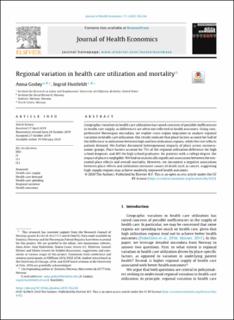Regional variation in health care utilization and mortality
Peer reviewed, Journal article
Published version
Permanent lenke
https://hdl.handle.net/11250/2660384Utgivelsesdato
2020-02-19Metadata
Vis full innførselSamlinger
- Artikler / Journal articles [426]
- Publikasjoner fra Cristin [138]
Sammendrag
Geographic variation in health care utilization has raised concerns of possible inefficiencies in health care supply, as differences are often not reflected in health outcomes. Using comprehensive Norwegian microdata, we exploit cross-region migration to analyze regional variation in health care utilization. Our results indicate that place factors account for half of the difference in utilization between high and low utilization regions, while the rest reflects patient demand. We further document heterogeneous impacts of place across socioeconomic groups. Place factors account for 75% of the regional utilization difference for high school dropouts, and 40% for high school graduates; for patients with a college degree, the impact of place is negligible. We find no statistically significant association between the estimated place effects and overall mortality. However, we document a negative association between place effects and utilization-intensive causes of death such as cancer, suggesting high-supply regions may achieve modestly improved health outcomes.
Utgiver
ElsevierTidsskrift
Journal of Health EconomicsOpphavsrett
© 2020 The Authors. Published by Elsevier
Med mindre annet er angitt, så er denne innførselen lisensiert som Navngivelse-Ikkekommersiell-DelPåSammeVilkår 4.0 Internasjonal
Beslektede innførsler
Viser innførsler beslektet ved tittel, forfatter og emneord.
-
Improving quality on health data, recommendations and guidelines - Based on the case of the Health Management Information System in Malawi and DHIS2
Hjemås, Geir; Bråthen, Remy; Vikan, Stein Terje; Haugen, John Åge (Notater / Documents;2017/5, Working paper, 2017-01-18)A Health Management Information System (HMIS) is an important element for a country’s capacity to monitor health, and for evaluating and improving the delivery of health-care services and programs. Many developing countries ... -
29 recommendations to combat social inequalities in health. The Norwegian Council on Social Inequalities in Health
Arntzen, Annett; Bøe, Tormod; Dahl, Espen; Drange, Nina; Eikemo, Terje Andreas; Elstad, Jon Ivar; Fosse, Elisabeth; Krokstad, Steinar; Syse, Astri; Sletten, Mira Aaboten; Strand, Bjørn Heine (Peer reviewed; Journal article, 2019)All political parties in Norway agree that social inequalities in health comprise a public health problem and should be reduced. Against this background, the Council on Social Inequalities in Health has taken action to ... -
Health status after cancer: does it matter which hospital you belong to?
Fiva, Jon Hernes; Hægeland, Torbjørn; Rønning, Marte (Journal article; Peer reviewed, 2010)Background: Survival rates are widely used to compare the quality of cancer care. However, the extent to which cancer survivors regain full physical or cognitive functioning is not captured by this statistic. To address ...

